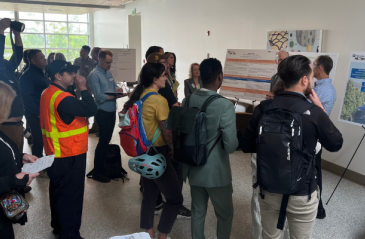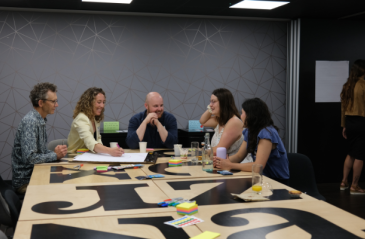
The information barriers holding back climate action and how to break them

Some of the best discoveries in human history occurred by accident, says @ChrisLSE
Share articleGovernments need to create the right environments to help foster innovations, says @ChrisLSE
Share articleSociety is increasingly vocal about the need to do things differently, @ChrisLSE
Share articleWe put our vision for government into practice through learning partner projects that align with our values and help reimagine government so that it works for everyone.
It's ironic when you think about it. Innovation is one of those concepts and ambitions that governments around the world have long striven for. To be more innovative is seen as being flexible, more dynamic, more customer-centric - the list goes on. And yet, as Christian Busch points out, the best results often occur by accident or from the unexpected encounter.
"The core assumption in this rapidly changing world is that we often don't really know which questions to ask or which people or resources we might need to tackle the complex problems that are always evolving," he says. "Take the field of chemistry, for example, where everything from penicillin to Viagra was discovered by accident - nobody was looking for them. But because they were really good at setting up these experiments and getting the right procedures and teams in place, they made it more probable that these coincidences would happen."
The focus now is on ensuring that similar environments can be created in governments, and elsewhere, to help foster innovations today - and tomorrow.
Busch knows what he's talking about. As associate director of the Innovation and Co-Creation Lab at the London School of Economics' (LSE) and cofounder of Leaders on Purpose, he has worked with companies to develop sustainable business models. He is also cofounder of Sandbox, the leading community of young innovators, which he has expanded into 20 countries. And at the LSE, his research focuses on innovation, entrepreneurship, social impact and social networks, which he combines with teaching several postgraduate and executive MBA courses.
Helping public and private organisations enhance the impact of their activities so that people and communities benefit - the social impact, in other words - is what really fuels his engine. Doing so relies heavily on organisations innovating and finding new ways to maximise their impact, with environments having a key role to play. "Luck and coincidence, by definition, always seem like something we can't control," concedes Busch. "But if we are clever enough to set up the environment so that these incidents can happen, then we might make innovation more probable."
Sounds good, so how can we do this? Busch believes that there are two main layers - both in terms of policy and at organisations themselves. "On the broader policy level, it can involve people meeting randomly at a conference, for example," he says. "And although they work in different fields, they then find that they have a lot of systems and processes in common and explore complementary ideas. So people who were previously completely disconnected can meet and share ideas that lead to new policy. It would certainly be very intriguing to look at which policies were triggered by these kinds of serendipitous encounters."
Busch's main focus, though, is how to do this at the organisational level - and it transpires that efforts are already under way to create or curate an atmosphere where people feel they can come up with new ideas. "For example, a couple of guys at NESTA have tried out a 'randomised coffee trial', where they have people randomly meet - creating an encounter that they wouldn't usually have, and talk about things they would not usually talk about. This is a simple mechanism which enables people to have more serendipitous encounters. After all, this is all about curating serendipity.”
This type of activity is especially useful in governments, which by their very nature can often appear labyrinthine to penetrate. Their structures - with different ministries and agencies, together with the divide that often exists between policy and delivery teams - means that innovation can often flounder rather than flourish. Busch agrees that this is a real challenge but goes on to say that progress made in developing countries offer some valuable chinks of light.
"In South Africa, the foundation of Reconstruction Living Labs was the trust that exists on the local level, and which is harder to find at government level or in multinationals," he says. "They set up a super simple educational methodology of teaching each other how to use social media, and they took this simple approach and scaled it to 5 million people. They did this by working with local community leaders, identifying any problems, and using a methodology that works directly with the local structures."
He also goes on to cite the impact of Gyan Shala, an NGO which works in Bihar, which is one of India's biggest and most impoverished states. Its focus is on improving the educational infrastructure, identifying teachers who might benefit from additional skills training and schools that are not set up for the scale of challenges they are facing.
"An organisation like Gyan Shala - locally based and staffed, and in touch with local needs - can train a local person to become a teacher within a couple of months," explains Busch. "This is far faster than the government is able to do. These kinds of initiatives are extremely interesting because they constantly innovate in order to be relevant to the local communities. The government can benefit from this because, in a way, it is outsourcing the risk of innovation and experimentation - in other words, the stuff that can be difficult to explain to voters as it sometimes involves failures. But they can then cherry-pick the interesting parts which worked out, and implement them into their programmes, combining bottom-up innovation with top-down coordination."
The successes of initiatives in Bihar and elsewhere, together with the power and potential of serendipitous innovation, have helped persuade Busch that the future is bright. Clearly, there are governments out there doing exceptional work - we just need more of them.
"I'm an eternal optimist anyway, but when I look at the innovation landscape, what I find interesting is that there are governments which are identifying the organisations that are experimenting and constantly innovating," he says. "They understand that they don't need to insert themselves into the whole process - there is no need for them to take the steering wheel entirely - it's about identifying the right multipliers, and coordinating the emerging ecosystem."
Underpinning his positivity is the fact that society is increasingly vocal about the need to do things differently. "People increasingly feel strongly about injustices out there, and there has to be something better," says Busch. "It's like we are looking for a new kind of enlightened capitalist model. For me, this comes down to working out how we can institutionalise an approach that ensures an organisation integrates social, environmental and financial impact at the same strategic level, rather than just a corporate social responsibility initiative on the sidelines. Thus, it's about becoming an Impact Organisation."
The time is ripe, he believes, for such a transformation to occur. "The current generation is far more heavily focused on which models have a positive impact," he says. "There are so many more people who want to put their money into more impactful vehicles, and want to lead and work for companies that are rooted in this kind of integration. The task now is to look into the patterns and structures behind those organisations that seem to do this the best. And then spread the secrets behind their success and, more importantly, their small and big obstacles and failures along the way and how they overcame them."
When this happens, the positive impact will follow - and this time, not by accident.












